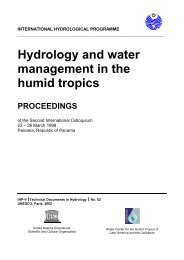FR AB - Science Reference
FR AB - Science Reference
FR AB - Science Reference
You also want an ePaper? Increase the reach of your titles
YUMPU automatically turns print PDFs into web optimized ePapers that Google loves.
Matrix-Assisted Laser Desorption Ionization<br />
Time-of-Flight Mass Spectrometry<br />
One microliter of a sample solution of approximately<br />
10 to 50 pmole/�L was combined with 1 �L of 4hydroxy-alpha-cyano-cinnamic<br />
acid matrix solution<br />
(Hewlett-Packard, Palo Alto, CA), and the mixture<br />
was deposited on a stainless steel target (2 spots/sample).<br />
MALDI-TOF analyses were performed on either<br />
a Voyager Elite or a Voyager DE-STR mass spectrometer<br />
(Applied Biosystems) in reflectron mode with<br />
delayed extraction. A two-point external calibration<br />
based on angiotensin II (m/z 1046.54, MH � ) and<br />
adrenocorticotropic hormone (ACTH) 18 to 39 Clip<br />
peptide (m/z 2465.2, MH � ) was used for the molecular<br />
mass determinations. Post-source decay (PSD) experiments<br />
were performed on the Voyager DE-STR.<br />
Data were acquired in 10 consecutive frames, lowering<br />
the reflectron voltage by 25% at each step. Air was<br />
used as collision gas while focusing on the low mass<br />
region (m/z � 200). The data were smoothed to yield<br />
mostly average masses. ACTH-Clip peptide was used<br />
for PSD calibration.<br />
Sequence Analysis<br />
Selected peptides were sequenced by Edman degradation<br />
using an Applied Biosystems model 494 protein<br />
sequencer and an Applied Biosystems model<br />
120A HPLC analyzer fitted with a reverse-phase (RP)<br />
HPLC column.<br />
RESULTS AND DISCUSSION<br />
Analysis of the Test Peptide<br />
The integrity of the reference peptide was confirmed<br />
by amino acid analysis, capillary electrophoresis,<br />
Edman degradation, RP-HPLC, MALDI-TOF/MS, and<br />
STRATEGIES FOR SYNTHESIS OF L<strong>AB</strong>ELED PEPTIDES<br />
FIGURE 1<br />
Elution position of PTH-Lys(biotin) by<br />
Edman sequence analysis. The Lys(biotin)<br />
is well resolved from other amino acids<br />
and can easily be identified.<br />
ESI/MS. All analyses gave the anticipated results. As<br />
shown in Figure 1, PTH-Lys(biotin) was well resolved<br />
from the other amino acids during Edman degradation<br />
analysis.<br />
The ESI mass spectrum of the test peptide is<br />
shown in Figure 2. Three charge states of the peptide<br />
were readily detected: m/z 1173.7, [M�H] � , m/z<br />
587.5, [M�2H] 2� , and m/z 392.1, [M�3H] 3� . The tandem<br />
mass spectrometry (MS/MS) spectrum obtained<br />
by collision-induced dissociation of the 2� ion confirmed<br />
the expected sequence (Fig. 3).<br />
Analysis of Submitted Peptides<br />
Thirty-four peptides were submitted in crude form by<br />
participating laboratories. Eight different methods<br />
were used for the synthesis. The best crude material<br />
was found to be 96% pure by RP-HPLC. A summary<br />
of the analytical data for the submitted peptides is<br />
presented in Table 1. The following results were obtained:<br />
1. Nine of the peptides were constructed using a<br />
prelabeled Lys(biotin), yielding from 0% to 88%<br />
correct product by HPLC. In three of these peptides,<br />
the Lys(biotin) was not efficiently coupled.<br />
2. Eleven laboratories used Fmoc-Lys(Dde)-OH (as<br />
did the PSRG). Three of these submitted samples<br />
contained no correct product. One contained the<br />
Lys(biotin) but was missing the Arg. The other<br />
two samples contained two biotins. The attachment<br />
of the extra biotin was the result of the fact<br />
that Boc-Ala-OH was not employed as the N-terminal<br />
residue. These last two laboratories also<br />
used modified biotins.<br />
3. Nine laboratories used Fmoc-Lys(Mtt)-OH. Of<br />
these samples, one had no correct product and<br />
was missing the biotin, and another contained<br />
only low levels of the requested peptide. For this<br />
synthesis, the Mtt group must be selectively<br />
JOURNAL OF BIOMOLECULAR TECHNIQUES, VOLUME 11, ISSUE 4, DECEMBER 2000 157















